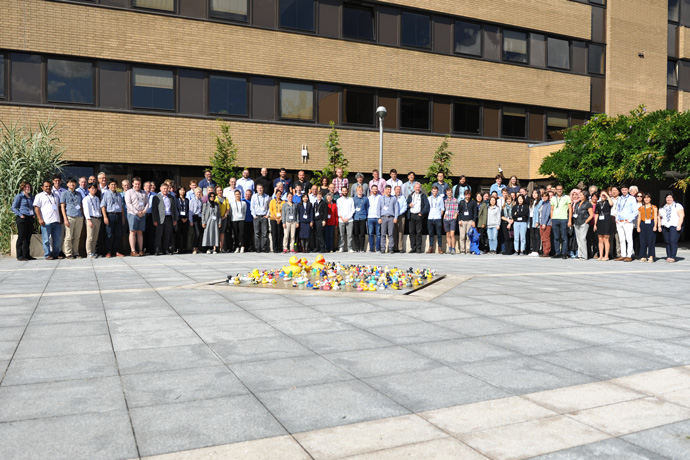ECMWF | Reading | 2-5 September 2019

Subseasonal and seasonal forecasting: recent progress and future prospects
More than two decades ago, seasonal forecasting started as a pilot project at ECMWF. Now it is a corner-stone of climate services. Originally a spin-off from seasonal forecasting, the sub-seasonal range covered the then so-called predictability desert; now it is a key building block of the seamless forecasting strategy, with clear prospects for useful skill gains at week 3 and 4.
Although the predictable processes and predictability drivers differ between the subseasonal and seasonal scales, prediction at these time ranges is a combination of initial and boundary problems. Sub-seasonal and seasonal predictions act as a bridge between weather and climate.
This seminar reviewed recent advances in our understanding of the predictability at these time scales. It presented current forecasting capabilities, and summarised recent but consolidated findings from numerical experimentation and exploitation of public data bases. It also provided a perspective of incipient developments related with data exploration, forecast products and predictability drivers, which will shape the future of seamless forecasting systems.
Sessions and programme
Session 1: Basis for predictability at the extended and seasonal range
Chair - Magdalena Alonso Balmaseda (ECMWF)
Session 2: Physical processes, modelling and initialisation requirements
Chair - Tim Stockdale (ECMWF)
Session 3: System Design
Chair - Frederic Vitart (ECMWF)
Session 4: Detecting and exploiting skill
Chair - Antje Weisheimer (ECMWF)
Session 5: Databases for science and applications
Chair - Laura Ferranti (ECMWF)
Presentations and recordings
Monday 2 September 2019
|
Welcome and opening |
n/a |
|
|
Introduction and arrangements |
n/a |
|
|
A personal perspective on predictability on sub-seasonal to seasonal time-scales |
||
|
Taming the butterfly effect to reach subseasonal and seasonal predictability |
||
|
Predictability associated with teleconnections from tropical phenomena |
||
|
The complexity of ENSO and its impacts: lessons learnt from initialized predictions |
Tuesday 3 September 2019
|
The Madden-Julian Oscillation |
||
|
Multi-Scale Impacts of Extratropical Ocean on the Atmosphere |
||
|
Land surface as a predictability driver in Subseasonal and seasonal Forecasts |
||
|
High-latitude processes in sub-seasonal to seasonal predictions |
||
|
The role of atmospheric composition in the predictability at the S2S scale |
||
|
The role of the stratosphere for sub-seasonal to seasonal forecasting |
||
|
Statistical methods for verification of probabilistic forecasts at the extended and seasonal range |
Wednesday 4 September 2019
|
Atmospheric teleconnections, the North Atlantic Oscillation and long range forecasts of European winters |
||
|
Seasonal forecasting systems: present and future |
||
|
Multi-week/seasonal prediction for agricultural applications in Australia |
||
|
The US Navy’s Extended-range Prediction System with High-resolution Ocean and Ice models |
||
|
How Using NASA’s Observations Affects the Balance Among Spatial Resolution, Ensemble Size, and Physical Complexity in the GEOS-S2S System |
||
|
Comparing the Predictability and Skill of Subseasonal Forecasts |
||
|
Predicting high impact weather events beyond the medium range |
||
|
Towards process-based narratives for seasonal climate predictions |
Thursday 5 September 2019
|
What did we learn from the S2S database? |
||
|
Bridging the Gap between Weather and Climate Prediction using Multi-model Ensembles |
||
|
Seasonal forecast data and information: the providers' perspective from the Copernicus Climate Change Service |
||
|
Subseasonal and seasonal climate forecast applications |
||
|
Analyzing causal pathways of the stratospheric polar vortex using machine learning tools |
||
|
Where our science ambitions meet computing and data handling limitations |
||
|
Close of seminar |
n/a |
Posters
|
Forecasting the onset of rainy season for African farmers |
|
|
Effect of Sea Ice Thickness Initialisation on Sub-seasonal to Seasonal Forecasting |
|
|
An Introduction to FGOALS-f2 S2S prediction system |
|
|
Sub-seasonal forecasts over Europe for the energy sector: current forecast status and an insight into model error |
|
|
The Madden-Julian Oscillation, the Euro-Mediterranean Weather regimes and Morocco winter precipitation |
|
|
Sources of seasonal predictability in the Mediterranean |
|
|
Improved QBO teleconnection due to reduced model circulation biases |
|
|
GEOS S2S Version 3: The New GMAO High Resolution Seasonal Prediction System |
|
|
Towards Typhoon forecasting in the S2S time scale |
|
|
Categorized correction forecast for accumulative precipitation of heavy rainfall processes based on optimal probability (OPPF) in medium-extended-range forecast time |
|
|
How can deep-learning assist physical modelling and forecasting? |
|
|
Preliminary results of introducing soil moisture data assimilation to the JMA Global Ensemble Prediction System |
|
|
iColt: results from the summer operational seasonal predictions of irrigation water need in Emilia-Romagna |
|
|
Calibration of ECMWF SEAS5 precipitation forecasts in Java (Indonesia) using statistical post-processing of precipitation and climate indices |
|
|
The wintertime North Atlantic response to increased ocean model resolution in the IFS across timescales |
|
|
Mechanisms and predictability of Sudden Stratospheric Warming in winter 2018 |
|
|
Impact of applying two-tiered sea surface temperature approach to Global Ensemble Prediction System |
|
|
SEAS5-20C: Biennial (24-month long) hindcasts for the 20th Century |
Organising committee
Magdalena A. Balmaseda, Gianpaolo Balsamo, Anca Brookshaw, Laura Ferranti, Tim Stockdale, Frederic Vitart, Antje Weisheimer
